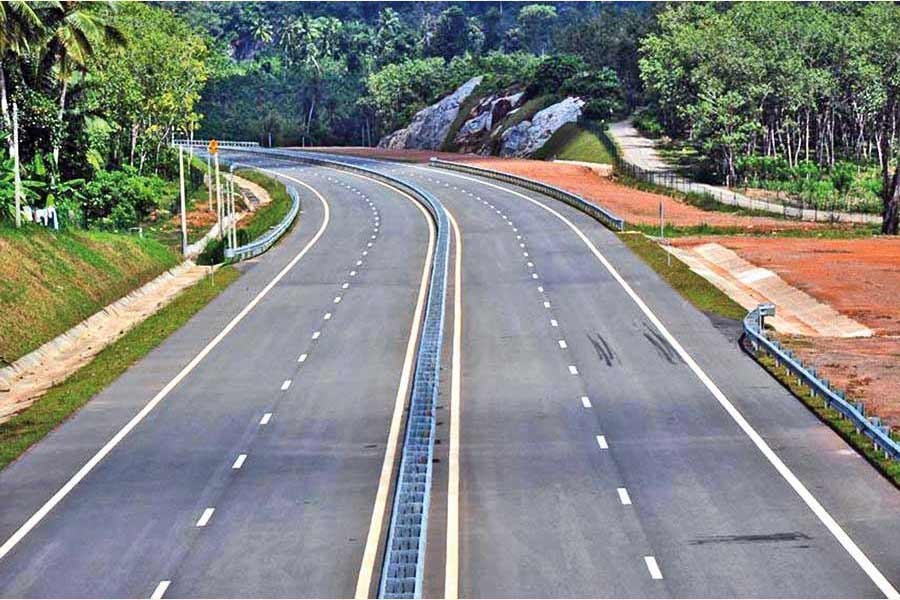Lots of grand promises were made immediately after the opening of the Dhaka-Chattogram 4-lane highway on July 17, 2016. There were ample reasons for the Road Transport and Highways Division for claiming the completion of the project. In an aerial view, portions of the highway looked spectacular. At the same time, the authorities concerned and policy makers seemed generous in presenting a raft of promises centring on the vital 4-lane highway, the country's first. With the undertaking of the Dhaka-Chattogram National Highway Upgrade Project, its original length of 250-kilometres is set to undergo major upgrades. They are expected to accommodate the ever-rising volume of traffic on this route. It's, thus, aptly called the nation's economic lifeline.
After its opening, the general educated public and businesses haven't failed to realise the importance of the road. It was mainly because the highway directly linked the Chattogram Port and City with Dhaka, and, also, the capital's surrounding business spots. Due to the apparent haste in constructing the highway, its prospects began being shrouded by a pervasive mood of heartbreak.
The state of a creeping disillusionment could be detected among the experts conversant with the construction of highways. It's a highly complicated assignment which warrants in-depth knowledge about construction of long-distance road communication, travel time, topography of regions the roads are set to go through etc. Against this backdrop, road users had great expectations from the country's first national highway and those built to serve the regional road users. The later-time short-distance expressways were also among them. To the dismay of improved road communication advocates, impediments of many types didn't take long to emerge. As feared, the first one was detected in the planning of the highway. It resulted in series of shocks on the part of road users. Few were prepared to term those irregularities accidental or completely free of the influence of unscrupulous quarters.
All this resulted in deviations from the original plans. It didn't take long for an anarchic traffic movement network to come to the fore. The most glaring stumbling block that surfaced shortly after the formal opening of the 250km highway involved an overpass at Fatepur in Feni. The hurdle continued to create long tailbacks in a large area. Experts ascribed the plight facing the freight and passenger transports to wrong planning of the infrastructure at this and other points of the highway. After making do with the oversight in the highway's design-making, and the sufferings caused to the people for some time, the impacts of the defect could eventually be alleviated. But long tailbacks kept returning whenever there were small and big disregarding of traffic regulations. Localised traffic gridlocks emerged as a day-to-day scene.
In just a few years, the condition of the 4-lane highway demonstrates the one of an overused road. Indeed, it is. There is an acute dearth of equipment to measure the exact traffic load being borne by the road. As a consequence, it is the highway surface which has to bear the brunt of these deficiencies. Many other freshly built highways in the country witness their bitumen carpet wearing off, potholes popping up, or many vital parts caving in. The non-motorised, or improvised and makeshift vehicles, which are off-limits to all highways, are seen plying the exclusive roads in utter disregard for the rules in force. Moreover, the regionally important highways are found without weighing machines, thus letting the roads embrace infrastructural harm on them.
The very thought of such a plight prevailing on national and regional highways may veritably trigger a sense of dread even in many least-developed countries. A few of them are located in South Asia or Sub-Saharan Africa. Being a country with a past of district board or inter-division roads built by the British colonial rulers, the extent of public neglect towards these communication networks only reminds of a national decline in propriety. This treatment of expensively built road projects leads many locals to feel ashamed before the foreign private or government constructors. Monsoon floods and excessive rains pose a great threat to the roads and highways in the country. In years, the flood surges completely submerge concrete roads in the regions filled with rivers. However, deluges do not occur quite often. The question that discomfits many involves the damages done on many roads during even moderate flooding. It boils down to the conclusion that the roads are not made as flood-proof ones. It's evident the threats of the onrush of water from nearby rivers or those upstream or the need for constructing strong embankments on roadsides hardly occur to the road planners or constructors. This pattern of construction ought to change. It's sad that few bother about this wastage of public money.
The unique social realities of Bangladesh and the behaviour of its nature have an impact on its highways. It's different from that encountered in many countries. Being a river-filled country prone to repeated flooding, protecting the highways emerges as a critical imperative. Large countries having networks of inter-state highways and expressways may not face this problem. As for India, it needs not worry about the flooding of its highways during monsoon. The thousands of kilometres-long roads connecting states located in far-flung regions in India have anti-inundation engineering setups in place. These roads connect India's southern regions with the northern ones, the western ones with the eastern regions. Sections of highways in eastern India comprising West Bengal, Bihar and parts of Assam remain vulnerable to monsoon floods. However, like in its vast railway network, India has lately focused on its nationwide highways. Except during the great floods, the freight movement on these roads appears to be coming free of many of the earlier inconveniences.
In other vast countries, like the US, excessive snowfalls create periodic impediments to vehicular movement on their highways. Impact of natural disasters on highways can hardly be avoided. But the roads' slipshod maintenance speaks only of a nation's cavalier mindset.


